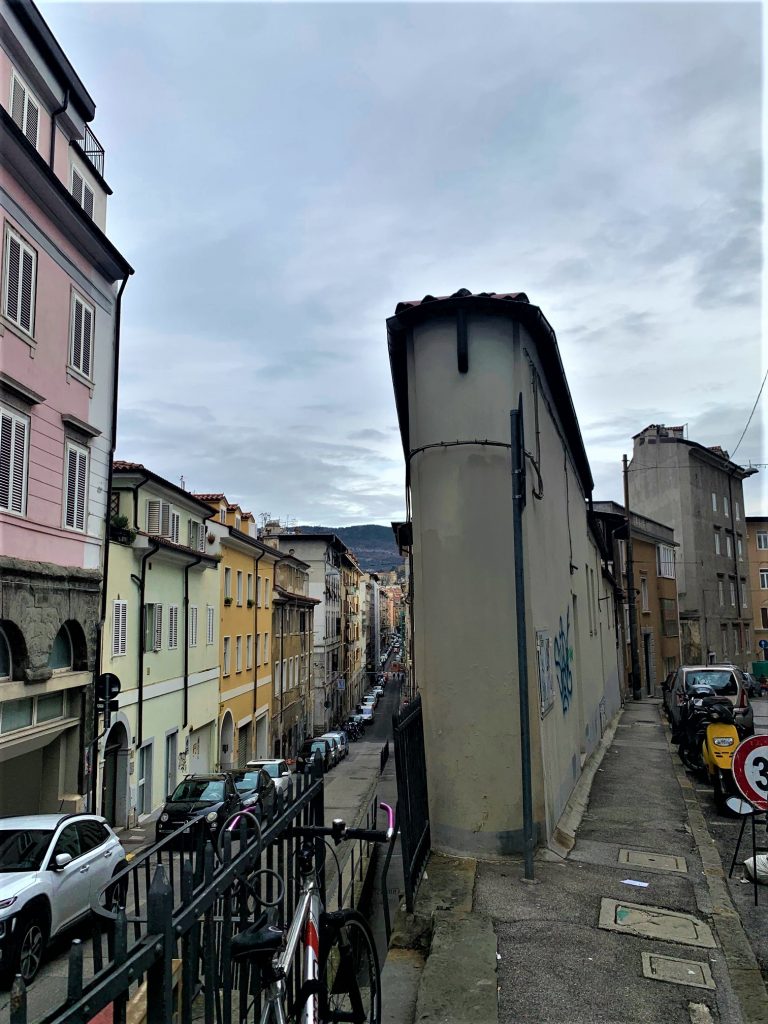by Alessandra Ressa
Just like New York City, Trieste too has its own “Flatiron” – the narrowest building in town. Located at the corner of Via del Bosco and Via Toti, this bizarre apartment house has stood there for over a hundred years, poised on the edge of the much neglected via del Bosco that climbs from busy Barriera to the quiet haven of San Giusto hill.
The building, located in via del Bosco 13, straddles the two roads in an interesting architectural outcome. This offers a unique perspective of town if you look at the building in the direction of hilly Carso. Trieste’s Flatiron has stairs on one side, and a winding street on the other. Its doors are positioned at different levels on each side, perfectly adapted to the uneven terrain it was built upon. In the shape of a sharp, acute triangle, the narrowest angle measuring less than a meter, this incredible building is definitely one of Trieste’s most curious sites, offering an unusual view of town.

Unlike the Flatiron building, which is probably one of the most iconic symbols of New York City, we don’t know much about Trieste’s poorer cousin. What these two buildings probably share is that they were built around the same time (at the very beginning of the 1900s) during a construction boom common to both continents. Surely in both cases, property and builders had a very limited lot of uneven land to be creative with. In New York, architects aimed for heights to compensate the limited perimeter, while in Trieste, a modest two-story building seemed more appropriate in a neighborhood characterized by low houses and stables.

Both in Trieste and New York the apartment buildings were meant to be used by the working class and toilets were scarce and shared by several tenants. In Trieste, where the building contained several tiny apartments, there was only one shared toilet for all.
The best apartments were those along the wider side of the triangle, the tiniest and most uncomfortable were those at the narrowest corner, with no windows and barely enough space to move about. To go from the ground floor to the first and the attic, a narrow spiral wooden stair stood precariously.
There is no particular history about this building. All that is known today is that a cobbler lived and worked in the narrowest part of the house. He had his shoe-repair laboratory in that narrow corner where via Toti and via del Bosco meet.

The tiny shop was located at street level and had a minuscule loft where the man had his makeshift bedroom he could reach after climbing a wooden ladder. The shoe-repair shop was so small that every time the poor man had to go to bed he had to remove his working table to make room for the ladder.
As he had no space for shelves to store the shoes he fixed, he hung them on strings which crisscrossed his tiny, dark lodgings or hung from the ceiling. According to an old resident of the area, entering the shop was not an effortless exploit, but once in there, you could not believe your eyes at the size of the place and the amount of suspended shoes everywhere. “He was a real business executive – remembers the resident – worked incessantly every day, went to church on Sunday and kept the shop closed on Monday, like all shopkeepers in Trieste”. According to the man, the shoe-repair shop closed over 40 years ago.

There are other buildings like this, triangular and narrow, along via del Bosco, only none as sharp-angled as the one we have just described. Leaning on to one another, these buildings, are a reminder of the area’s old architectural style. Incredibly, this used to be a suburban neighborhood, with several stables for horses and donkeys.
Today, although many buildings have been demolished and replaced, the atmosphere is definitely reminiscent of those gone times. With neglected apartment houses, their paint slowly fading and rare balconies full of vintage stuff, full of a general sense of abandonment that makes the area yet another fascinating spot in Trieste.





























Is this building in Treiste available for purchase?